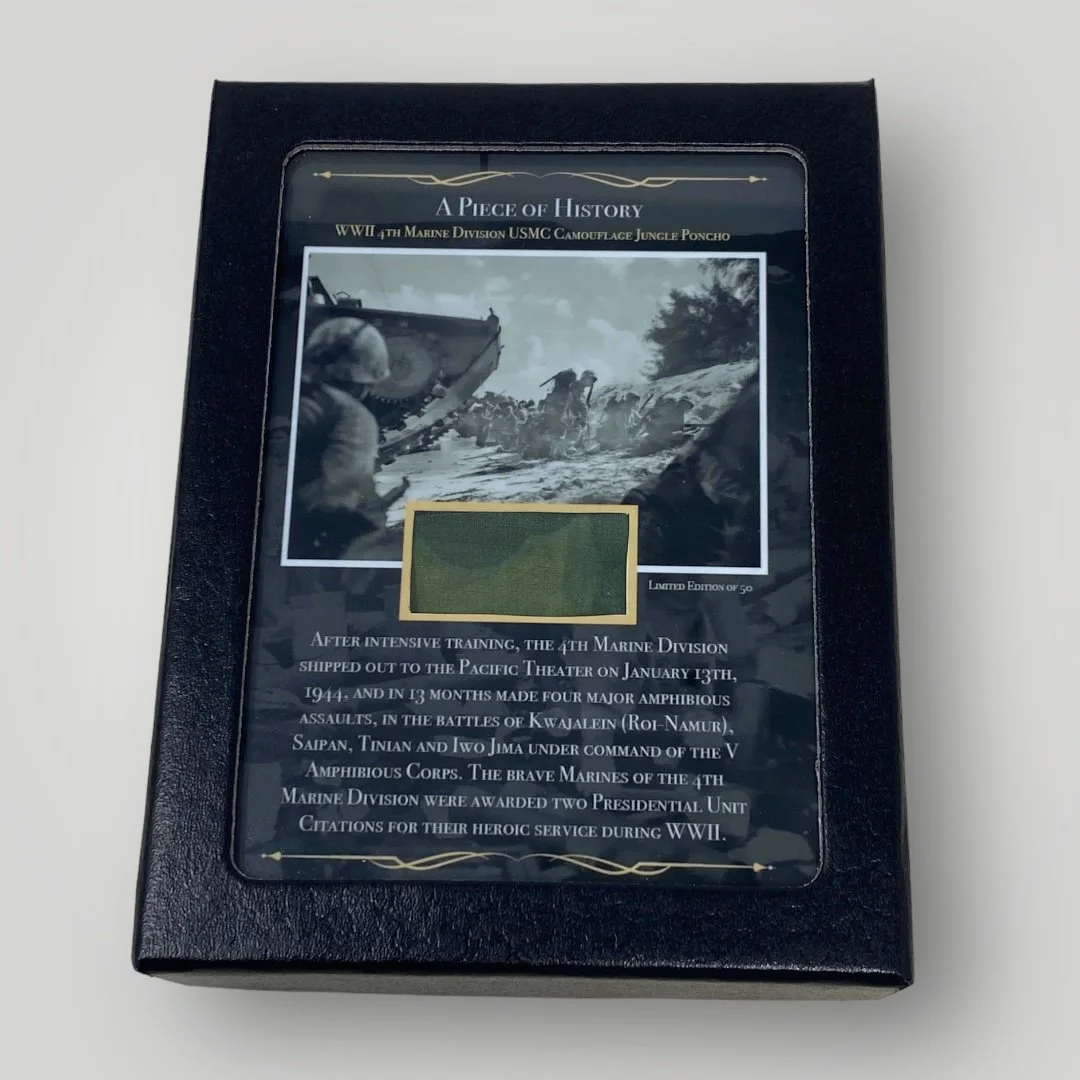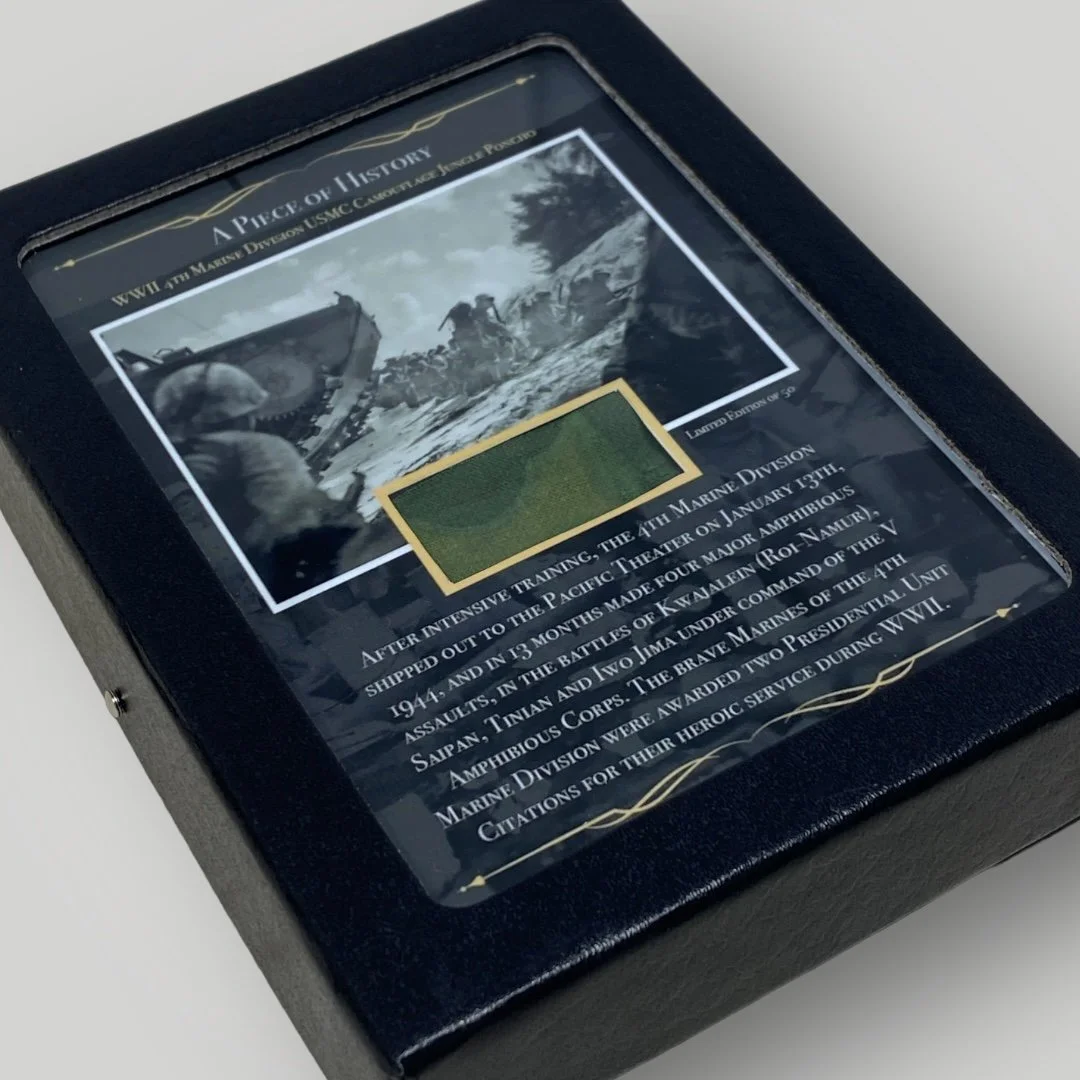RARE! WWII 4th Marine Division USMC Camouflage Jungle Poncho Gear Fragment Iwo Jima - Saipan - Tinian History Display Case (C.O.A. Included)












RARE! WWII 4th Marine Division USMC Camouflage Jungle Poncho Gear Fragment Iwo Jima - Saipan - Tinian History Display Case (C.O.A. Included)
Comes with a hand-signed C.O.A. and a full historical research write-up.
*Limited Edition of 50*
Own your piece of history today!
Due to an incredibly high demand for display case options, we are proud to offer one of our LIMITED EDITION series of HISTORIC DISPLAY CASE EXCLUSIVES. This incredible “Piece of History“ is professionally encased in a glass display case with plush padding and a tightly sealed display case. Each display features a historical photograph and a short description that corresponds to the artifact displayed. This display case measures a perfect 4.25 inches tall x 3.25 inches wide.
This series is a limited edition of 50 pieces, meaning that each “Piece of History” display is unique. The WWII 4th Marine Division USMC camouflage jungle poncho gear you receive may vary slightly from the display shown.
Due to incredibly high demand/requests, we are very proud to offer our first World War II USMC “Piece of History“ display!
This incredibly rare and very historic piece of WWII history is an original piece of WWII USMC camouflage jungle poncho that was worn by a U.S. Marine of the 4th Marine Division while in the Pacific.
The 4th Marine Division has a rich history of service during WWII. After intensive training, the 4th Marines shipped out in January 1944, and in just 13 months made four major amphibious landings at Kwajalein (Roi-Namur), Saipan, Tinian, and Iwo Jima under the command of V Amphibious Corps.
*In the last images of this listing, you will see one digitally sourced historical image of this item and its role in history!
World War II - 4th Marine Division:
The 4th Marine Division played a crucial role in the Pacific theater during World War II, contributing significantly to the Allied efforts in some of the most intense and pivotal battles of the conflict. Formed in August 1943, the division was composed of highly trained and disciplined Marines who faced some of the toughest challenges of the war, demonstrating exceptional courage, tenacity, and skill in the face of a determined enemy.
The 4th Marine Division's origins can be traced back to the early days of the war when the need for additional amphibious assault units became evident. The division was activated as part of the Marine Corps' expansion in response to the demands of a global conflict. Under the command of Major General Harry Schmidt, the 4th Marine Division quickly began intensive training, focusing on amphibious warfare and jungle combat in preparation for the challenges they would face in the Pacific.
One of the defining moments for the 4th Marine Division occurred during the Battle of Kwajalein in January 1944. This was the division's first major combat operation, and it marked the beginning of their baptism by fire. The Battle of Kwajalein was part of the larger Operation Flintlock, which aimed to capture strategic atolls in the Marshall Islands. The 4th Marine Division, alongside other Marine and Army units, spearheaded the assault on Kwajalein Atoll. Despite facing determined Japanese resistance, the division succeeded in capturing the atoll, showcasing their ability to execute complex amphibious operations.
Following the success at Kwajalein, the 4th Marine Division played a critical role in the Battle of Saipan in June 1944. Saipan was a pivotal engagement, as its capture would provide a strategic base for further Allied operations in the Pacific. The division faced fierce Japanese resistance, including intense artillery barrages and banzai charges. The Marines' resilience and skillful execution of amphibious assaults played a crucial role in securing victory, but the battle came at a high cost, with significant casualties on both sides.
The 4th Marine Division's next major engagement was the Battle of Tinian, which took place in July 1944. Tinian, like Saipan, was a vital stepping stone for the Allied advance towards Japan. The division's amphibious assault on Tinian was marked by coordinated land, sea, and air operations. The Marines faced well-fortified Japanese positions and engaged in intense fighting across the island. The successful capture of Tinian further demonstrated the effectiveness of the 4th Marine Division in amphibious warfare and solidified their reputation as a formidable force in the Pacific.
The division's combat prowess was again put to the test during the Battle of Iwo Jima in February 1945. Iwo Jima, a small volcanic island, was strategically important for its airfields and proximity to Japan. The 4th Marine Division, alongside the 5th Marine Division, bore the brunt of the assault. The battle was one of the bloodiest in Marine Corps history, characterized by fierce resistance from entrenched Japanese forces in a complex network of tunnels and bunkers. The iconic image of the raising of the American flag on Mount Suribachi, captured by Associated Press photographer Joe Rosenthal, remains one of the most enduring symbols of the Pacific campaign and highlights the tenacity and sacrifice of the 4th Marine Division.
The 4th Marine Division's final major campaign of World War II was the Battle of Okinawa, which began in April 1945. Okinawa was the largest amphibious assault in the Pacific and aimed to secure a base for the eventual invasion of Japan. The division faced determined Japanese resistance, kamikaze attacks, and a challenging terrain that included dense forests and fortified positions. The Battle of Okinawa was marked by some of the fiercest fighting of the war, and the 4th Marine Division played a crucial role in securing victory despite the high cost in casualties.
The war in the Pacific ended with the dropping of atomic bombs on Hiroshima and Nagasaki in August 1945, prompting Japan's surrender. The 4th Marine Division, having played a pivotal role in the Pacific island-hopping campaign, had fulfilled its mission with valor and distinction.
In reflecting on the achievements of the 4th Marine Division during World War II, it is essential to recognize the sacrifices made by the Marines who served in its ranks. The division faced formidable challenges in the form of well-entrenched Japanese forces, harsh environmental conditions, and the inherent difficulties of amphibious warfare. The success of the 4th Marine Division in these campaigns was a testament to the training, discipline, and courage of its personnel.
The legacy of the 4th Marine Division in World War II is indelibly marked by its contributions to the Allied victory in the Pacific. The division's performance in key battles demonstrated the effectiveness of amphibious assaults and underscored the importance of well-trained and adaptable military units. The Marines of the 4th Marine Division left an enduring mark on the history of the United States Marine Corps and are remembered for their bravery, resilience, and commitment to the defense of freedom during a pivotal period in world history.